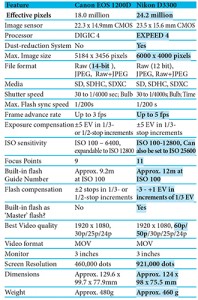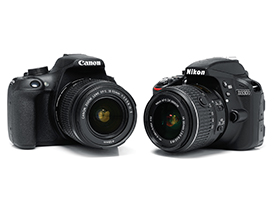 Canon and Nikon are evenly matched when it comes to the range of inventory. Also, the image quality depends on the camera-lens combination, rather than the body or lens taken separately. So a comparison of professional D-SLRs can throw up varying results depending on the lens-body combination. However, entry-level D-SLRs usually come bundled with their standard kit lenses and this is the combination that most beginners are likely to use. So a head-to-head comparison between two entry-level D-SLRs makes perfect sense. Both Canon and Nikon launched their upgraded entry-level D-SLRs within a month of each other. Here we compare the Canon EOS 1200D and the Nikon D3300, bundled with their respective standard 18-55mm kit lenses.
Canon and Nikon are evenly matched when it comes to the range of inventory. Also, the image quality depends on the camera-lens combination, rather than the body or lens taken separately. So a comparison of professional D-SLRs can throw up varying results depending on the lens-body combination. However, entry-level D-SLRs usually come bundled with their standard kit lenses and this is the combination that most beginners are likely to use. So a head-to-head comparison between two entry-level D-SLRs makes perfect sense. Both Canon and Nikon launched their upgraded entry-level D-SLRs within a month of each other. Here we compare the Canon EOS 1200D and the Nikon D3300, bundled with their respective standard 18-55mm kit lenses.
Design and Build Quality
In terms of design, the first thing to say is that the 1200D is designed like a Canon and the D3300 is designed like a Nikon. So we are ignoring the trivial design elements such as the placement of power button, command dials and buttons. The Nikon is lighter and slightly smaller than the Canon. The AF-S Nikkor 18-55mm 1:3.5-5.6G VR II lens is shorter and diametrically smaller than the Canon EF-S 18-55mm 1:3.5-5.6 IS II lens. The Canon lens has a 58mm filter thread, while the Nikon lens has a 52mm thread. The Nikon offers slightly better grip, while the Canon’s rubber lining on the grip feels more durable. Both are evenly matched when it comes to build quality, except for the smaller kit lens and the lighter body of the D3300.
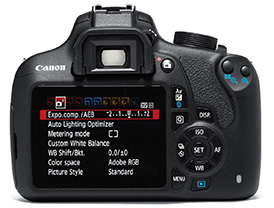
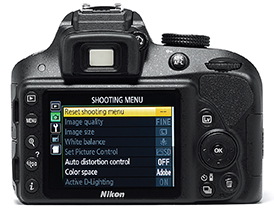 Key Features
Key Features
The following table will give you an idea of how the key features are matched. The highlights indicates ‘Better’. It is not too difficult to judge who the winner is. While Nikon upgraded the D3200 with their latest EXPEED 4 processor, Canon did not incorporate the DIGIC 5 or the latest DIGIC 5+ processor. The DIGIC 5+, according to Canon, is 17 times faster than the DIGIC 4, and it would have made a huge difference in performance. Even the other key features pale in comparison to the D3300. On the features front, the Nikon is a clear winner.
Ergonomics
Both the Canon 1200D and the Nikon D3300 match well when it comes to the placement of dials and buttons on the camera, though the Nikon’s Live View appeared crisper, probably due to the higher resolution of the screen. What could make a real difference while using the camera is the placement of the memory card slot. While the 1200D’s card slot is within the battery compartment, the D3300’s Memory card slot is at the side, on the grip. The Nikon’s design enables faster access and also facilitates changing of memory card with the camera mounted on a tripod. The 1200D may require unmounting from the tripod to change the memory card especially if the camera plate is large. Another factor that goes in favour of the Nikon is the non-rotating filter thread of the kit lens, which allows the use of polarisers and graduated filters.
Here again, the Nikon edges ahead.
Performance
Autofocus
Both the cameras focussed well and fast when using the optical viewfinder.
But Live View focussing made the real difference. Most of the times, the Canon 1200D simply kept on hunting for focus, while the Nikon D3300 had no problems with focussing even under low light. To make matters worse, the Canon’s focussing process made lot of noise while the Nikon’s was barely audible.
Continuous Shooting
To check the continuous shooting speeds of the cameras, we used two identical SanDisk 4GB Class 4 SD HC memory cards. Though the specified speeds are true only for Class 10 cards, the Class 4 cards would still be a fair comparison. Both cameras were set to High Speed Continuous mode and we checked the time for JPEG and Raw images separately. Canon shot 12 JPEG Large and Fine images in 4.5 sec before the buffer got full, clocking 2.6 frames per second, and took approximately 15.4 sec to write the images to the card. The Nikon, on the other hand, shot 11 JPEG Large and Fine images in 3.4 sec before filling the buffer, achieving 3.2 frames per second, and took approximately 24.5 sec to write the images to the card. In case of Raw images, The 1200D shot 5 frames in 2.8 seconds before running out of buffer space, providing approximately 1.8 frames per second, while the D3300 shot 5 frames in 1.4 sec, providing approximately 3.6 frames per second. While the Canon took 30 sec to write the images to the card, the Nikon took 26 sec.
While the D3300 had better continuous shooting speed, the 1200D had slightly better writing speed in the case of JPEG images. However, the Canon was slightly slower to write Raw images on to the card, probably because of the higher bit depth of Canon Raw images.
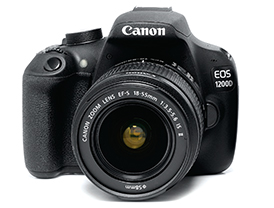
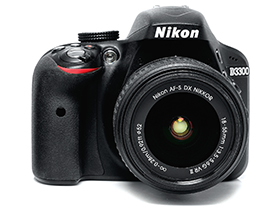 Darkening of Corners
Darkening of Corners
The Canon 1200D offers Peripheral Illumination Correction, whereas the Nikon D3300 does not incorporate any such feature. This feature was kept ‘On’ in our test since it is crucial to evaluate how well the camera-lens combination handles Darkening of Corners at the wide-angle end. Both the lenses were kept at their widest apertures at the wide-angle end. Here the Canon 1200D controlled the darkening very well, producing almost imperceptible darkening at the extreme corners, while the Nikon D3300 exhibited prominent darkening.
Flare and Chromatic Aberration
To test flare and chromatic aberration, we photographed some tree branches with the sun peeping through them. While we observed strong flare and heavy purple fringing in case of the 1200D, the D3300 controlled flare very well. We did not observe any fringing in the Nikon.
Distortion
In the test for distortion, we kept the Auto Distortion Control feature ‘On’ for the D3300, while the 1200D does not offer any equivalent feature. Both lenses produced some barrel distortion at the wide-angle range up to about 24mm (marked focal length). However, the Nikon produced slightly less distortion than the Canon.
Sharpness
The sweet spot of the Canon lens shifted from f/5.6 to f/8 from 18 to 55mm, while the Nikon’s sweet spot remained consistent at f/11. From 18mm up to about 35mm, the Nikon combination had a clear advantage without a hint of doubt. But towards the telephoto end, the Canon combination showed marked improvement. It was difficult to determine which one was better.
Metering
Both the cameras fared well in metering. We have no complaints about the metering of either cameras. Since both the cameras have different field-of-view crop factors, we couldn’t make the frame exactly similar. So we give the benefit of doubt though there was 1EV difference between the exposures.
Auto White Balance We tested the Auto White Balance performance of both the cameras by photographing a standard Gretag Macbeth colour chart in daylight. Other light sources were not used because in the case of artificial light sources, the colour temperature is greatly inconsistent. Both the cameras produced ideal tones.
Noise
Though the 1200D’s specifications mention that the ISO sensitivity can be expanded to 12,800 equivalent, we could set it only up to 6400 manually in our settings. The Nikon D3300 has approximately 6 million photosites more than that of the Canon 1200D, squeezed on to the sensor. Hence each of the 1200D’s photosites covers almost 20 percent more area than that of the D3300. This means that each photo diode in the 1200D captures almost 20 percent more light than the D3300, and more light captured means less noise. This was evident in our noise test. The Canon proved its mettle at all ISOs and its images were perfectly usable up to ISO 3200, while the Nikon’s images were usable only up to ISO 1600.
Value for Money
The Canon 1200D retails with the 18-55mm IS II kit lens at an MRP of Rs.34,995, while the Nikon D3300 carries a price tag of Rs.37,950 with AF-S 18-55mm VRII kit lens. The value for money depends on the performance and the other parameters. When we compare the price tags in this way, we feel the Nikon D3300 is better in terms of value for money, though it is more expensive by about Rs.3000.
Canon EOS 1200D
Fina l Score 75%
Design and Build Quality 16/20
Key Features 15/20
Ergonomics 16/20
Performance
Autofocus and 2.5/5
Burst Shooting
Darkening 4.5/5
of Corners
Flare and 2.5/5
Chromatic Aberration
Distortion 3.5/5
Sharpness 3/5
Metering 4/5
Auto W/B 4/5
Noise Control 4/5
Sub-Total 28/40
Value for Money 7/10
Total 82/110
Nikon D3300
Fina l Score 82%
Design and Build Quality 17/20
Key Features 18/20
Ergonomics 18/20
Performance
Autofocus and 4/5
Burst Shooting
Darkening 2.5/5
of Corners
Flare and 4/5
Chromatic Aberration
Distortion 4/5
Sharpness 4/5
Metering 4/5
Auto W/B 4/5
Noise Control 2.5/5
Sub-Total 29/40
Value for Money 8/10
Total 90/110
VERDICT
It is surprising to see a head-to-head comparison of two close competitors yielding such a clear result. At most stages, there was no ambiguity about which was better. The images spoke for themselves except in the case of Auto White Balance and Metering. Both the cameras have their advantages as well as flaws. Both are very close to each other in performance. In fact, a better kit lens would have certainly tilted the balance in Canon’s favour, but better lenses are more expensive. Overall, the Nikon D3300 is the champion of the Flyweights along with the kit lens.
Sujith Gopinath

